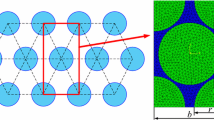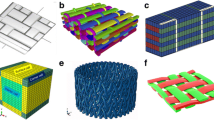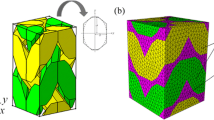Abstract
Textile composites are applied to aerospace and automotive industries because they have good fatigue characteristics, and higher specific stiffness and strength compared to metallic materials. In addition, textile composites have better out-of-plane performances such as the resistance of impact and inter-laminar delamination, in addition to greater structural flexibility than the traditional unidirectional composite materials. In this paper, we studied a stiffness prediction method for the effective stiffness of triaxial braided composites accounting for manufacturing parameters such as fiber volume fraction, number of filaments in a yarn, braiding angle, and gap between fiber yarns. The repeating unit cell (RUC) of the triaxial braided composites and the geometric model of yarn architecture were defined in consideration of the gap between adjacent yarns. The gap size between yarns was measured from the photographic image of the cross-section of the triaxial braided composite specimens. The fiber yarn discretization method and the stress averaging method were applied to predict the effective mechanical properties of triaxial braided composites. The predicted properties by the proposed model have good agreement with experimental results.














Similar content being viewed by others
References
Carl TH (1998) Mechanics of fibrous composite. Wiley, Amsterdam
Niu MC (1992) Composite airframe structures. Conmilit Press Ltd., Hong Kong
Naik NK (1994) Woven fabric composites. Technomic Publishing Co. Inc, Lancaster
Chou T-W, Ko FK (1989) Textile structural composites. Elsevier, Amsterdam
Cox BN (1997) Handbook of analytical methods for textile composites. NASA Contractor Report 4750, Contract NAS1–19243
Chou T-W, Ishikawa T (1989) Analysis and modeling of two-dimensional fabric composites. Composite Materials Series 3, Textile Structural Composites, pp 210–264, Elsevier, Amsterdam
Ko FK, Pastore CM, Lei C, Whyte DW (1987) A Fabric Geometry Model for 3-D Braid Reinforced FP/AI-Li Composites. International SAMPE Metals Conference: Competitive Advances in Metals/Metal Processing. Cherry Hill, NJ
Pastore CM, Gowayed YA (1994) A self-consistent fabric geometry model: modification and application of a fabric geometry model to predict the elastic properties of textile composites. J Compos Technol Res JCTRER 16(1):32–36
Ma C-L, Yang J-M, Chou T-W (1986) Elastic stiffness of three-dimensional braided textile structural composites. Composite Materials: Testing and Design, ASTM STP 893, Philadelphia, pp 404–421
Foye, R. L., “Finite Element Analysis of the Stiffness of Fabric Reinforced Composites,” NASA CR-189597 (1992) National Aeronautics and Space Administration. Hampton, Virginia
Xu L, Kim SJ, Ong CH, Ha SK (2012) Prediction of material properties of biaxial and triaxial braided textile composites. J Compos Mater 46(18):2255–2270
Naik RA, Ifju PG, Masters JE (1994) Effect of fiber architecture parameters on deformation fields and elastic Moduli of 2-D braided composites. J Compos Mater 28:656–681
Naik RA (1994) Analysis of woven and braided fabric reinforced composites. NASA Contractor Report 194930, Contract NAS1–19399
Naik R (1994) TEXCAD - textile composite analysis for design. NASA Contractor Report 4639, Contract NAS1–19708
Chamis CC (1983) Simplified composite micromechanics equations for hygral, thermal and mechanical properties. NASA Technical Memorandum 83320
Shu Ching Quek (2003) Analysis of 2D triaxial fiat braided textile composites. Int J Mech Sci 45:1077–1096
Kier ZT (2015) Estimating mechanical properties of 2D triaxially braided textile composites based on microstructure properties. Compos Part B 68:288–299
Kim MJ (2020) Mechanical properties prediction by manufacturing parameters for braided composites. J Aerosp Syst Eng 14(4):26–32
Mekonnen AA, Woo KS (2020) Effects of defects on effective material properties of triaxial braided textile composite. Int J Aeronaut Space Sci 21:657–669
Author information
Authors and Affiliations
Corresponding author
Additional information
Publisher's Note
Springer Nature remains neutral with regard to jurisdictional claims in published maps and institutional affiliations.
Rights and permissions
About this article
Cite this article
Kim, M., Park, J. Stiffness Prediction of Triaxial Braided Composites Accounting for Manufacturing Parameters. Int. J. Aeronaut. Space Sci. 22, 602–612 (2021). https://doi.org/10.1007/s42405-021-00379-7
Received:
Revised:
Accepted:
Published:
Issue Date:
DOI: https://doi.org/10.1007/s42405-021-00379-7




